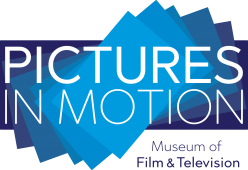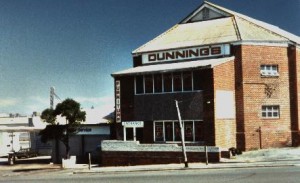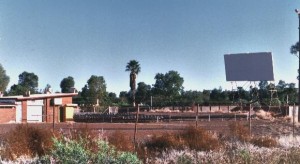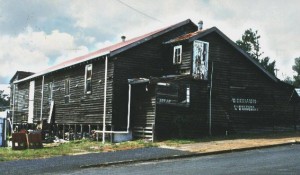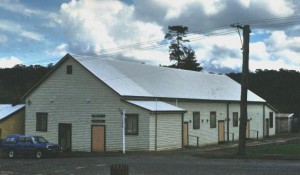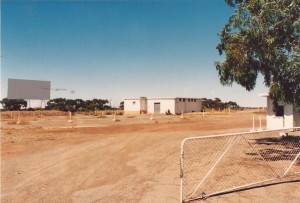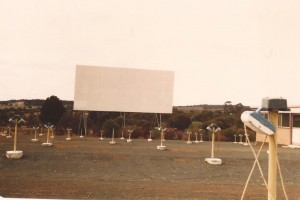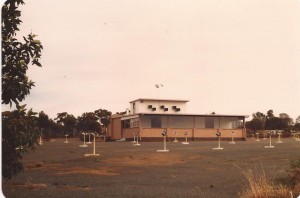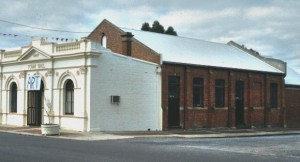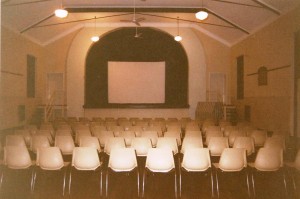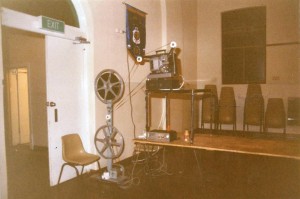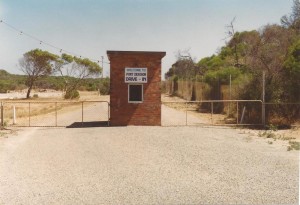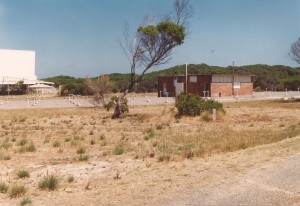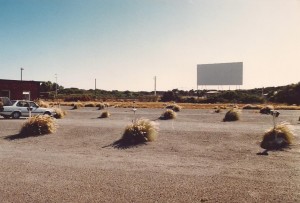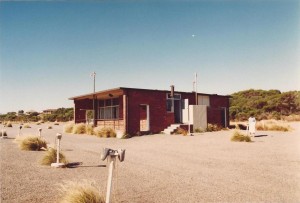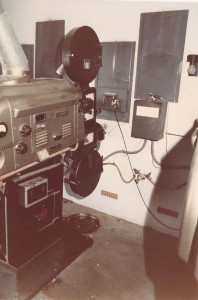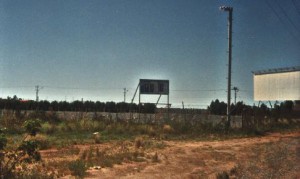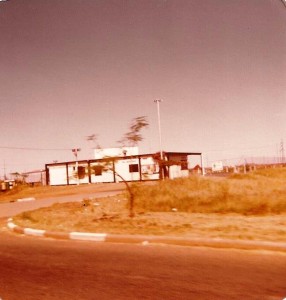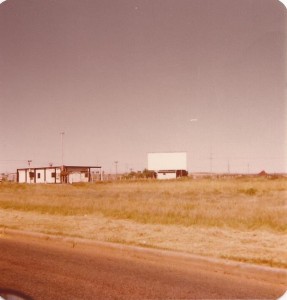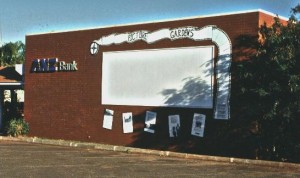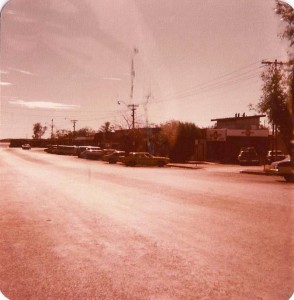Quicklinks
| Palgarup | Palmyra | Pannawonica |
| Paraburdoo | Pemberton | Perenjori |
| Piawaning | Pingelly | Pingrup |
| Pinjarra | Pithara | Porongurup |
| Port Denison | Port Hedland |
PALGARUP
HALL, Palgarup
Allan Jones was listed in the Film Weekly Directory as screening here from 1940/41 to 1957/8.
Sources: Film Weekly Directory 1940/41 – 1957/8
PALMYRA
EMPIRE/SWAN/MAYFAIR, 6 Canning Rd, Palmyra
The Empire Hall, owned by the then Mayor of Fremantle, Mr Herbert Locke, appears to have been used as a regular film exhibition venue from at least 1927, under the name of Empire Pictures. In 1932 James McKerchar leased the hall, and renamed the venue Swan Suburban Pictures. He renovated it, including putting in a tissue paper ceiling to improve the acoustics, which had been a source of complaint from patrons after the introduction of sound. He bought the land next door and built the gardens himself, opening them in 1933. In 1936, he moved on to the Beacon at East Fremantle, after selling the Swan gardens to Locke, who then operated both the theatre and gardens through his family company, Richmond Theatre and Gardens Co. In 1936, the company built the Mayfair cinema, with shops fronting onto the road. This opened in 1938, with the theatre and the gardens now each holding 800, though slightly less by the time they closed. The programmes screened were identical with those in the company’s other cinema, the Richmond, further down the highway towards Fremantle: as each ran a double feature, during intermission Reg Franklin (Herbert Locke’s son-in-law, who ran both theatres) would switch the films in his car. The Mayfair Theatre and gardens closed in 1961, the dress circle was converted into a mezzanine floor which became a supermarket, while the upstairs was used for bingo. Later still the premises were converted into a furniture shop operated by Percy Dunning, and the gardens area became a car park. In 1983 the whole premises were sold.
Sources: Public Works Department, building permits (Battye 1459)
Max Bell, Perth: a cinema history, The Book Guild, Lewes, 1986 pp.48-9
Interview (Mark Turton): James McKerchar (1978)
Interview (Heather McRae?): Gladys Locke (1987)
Photos: 3 colour exteriors 1981 (Bill Turner)
PANNAWONICA
DRIVE-IN, Pannawonica
Pannawonica is a company town, built by Robe River Iron Associates for its workers and their families.
Eddie Wheeler says the 16mm was blown away, and he installed 35mm in 1987. In 1996, Max Bell reported that this venue had been badly damaged by a cyclone, but that Robe River were planning to rebuild and re-open.
Sources: Kino, no.58, December 1996, p.31
Interview (Ina Bertrand): Eddie Wheeler (1997)
PARABURDOO
OPEN AIR PICTURE GARDENS/ DRIVE-IN, Camp Rd, Paraburdoo
The township of Paraburdoo was built by the Hammersley Iron Co to house mine workers and their families. An open air gardens seating nearly 1000, was approved in 1973. No such venue ever operated in the town, but this approval may have been for the screenings provided at the construction camp, for the mine workers – screenings that continued even after the drive-in, built by N.J.Woods for the company on the south side of Camp Rd, next to the Caravan Park, opened in late 1972.
The drive-in was a large venue, with radio sound for cars and broadcast sound for the people sitting in the rows of plastic chairs forward of the bio-box. At first, it screened four nights a week: Thursday was an R-rated movie, Friday was for children, Saturday and Sunday were for families, once a month on a Tuesday they had a horror film. Because the speakers in car radios were not very good, people would drive down but sit outside where they could hear better. Some people took a picnic tea, but mostly people just went to see the movie. Good movies could draw large crowds, such as four nights for The Poseidon Adventure or Jaws, when the population of the town was about 2,500 (so just about everyone in the town saw it).
From the start, it was run by volunteers: the Recreation Club (Rec. Club) ran the film programmes, and four churches ran the food section (the Catholic Church, the Uniting Church, and – possibly – the Anglican Church and the Seventh Day Adventists). All labour was voluntary – from the ticket sales and food sales to projection and cleaning up after the screening.
Admission charges were set just high enough to cover the cost of food, and cost of the film – in the early days a ticket cost only 60c for an adult, and 20c for a school-age child. This was enough to cover expenses, with a little over – the four churches were raising money to build a church, and the Rec Club provided services, such as bringing live shows to the town.
Locals can remember the usual stories of children sneaking in without paying, and drunks making a nuisance of themselves. They also remember the night the teachers were smoking in their car, and the film had to be stopped while the fire brigade came in to put out the resulting fire. Snakes are common in the district, and it was not unusual to find one in the projection box… One projectionist left his children in his station wagon, with the back window open for them to get in and out. When he went out at interval to take food to them, he found a snake had climbed into the back of the wagon. Fortunately, the children had gone out to sit on the chairs!
Television did not make much difference to the drive-in. The town had MTN (Mining Television Network) from the beginning: this was programmes sent from South Australia, with children’s programmes (Cisco Kid and some ABC) starting at 5 p.m., ABC news from the day before coming through at 6 p.m., that day’s radio news coming through at 7 p.m. (this came through the television set, but without any picture). Regular broadcast television came in the 80s: ABC first, in mid-80s, then GWN (from Bunbury) a little later. But in the late 80s, video arrived, and that DID make a difference: screenings dropped back to three nights and cut out quite quickly after that.
In the late 1990s, the venue is still run by volunteer labour, but only by the Catholic Church, and with screenings only once a month. No canteen service is offered from the canteen building, because ‘it is walking away with white ants’: instead soft drinks and barbecue sausages are provided informally on the site. The Ashburton Shire has now taken over civic administration from Hammersley Iron, so the Shire owns the buildings. Though not enough is spent to maintain the venue in top condition, it remains an important part of the community’s life.
Sources: Public Health Department, building permit, Battye 1459
West Australian 1981
Interviews (Ina Bertrand): Irene McElhinney (1999), N.J.Woods (1985), Judy Woodvine (1999)
Photos: 1 exterior, colour, 1999, Graeme Bertrand
PEMBERTON
ADYAR HALL, Ellis St, Pemberton
The first building venture of Allan Jones of Busselton was the Adyar Hall at Pemberton, constructed in pique at the lease of the Mill Hall being given to a local resident. It was a timber hall, slightly smaller than the Mill Hall, but purpose-built for pictures, so with a built-in bio-box. It was located in Ellis St, just down from the north-east corner of the intersection of Ellis and Guppy Sts.
The first screening was on 7 September 1929 – Wings, followed by a dance. But 1929 was also the beginning of the Great Depression. As Jones was still in the early days of his career, he had to work extremely hard to make the new venture pay, going so far as using his van to bring in patrons from outlying farms, particularly in the Group Settlement areas, all for the same entrance price of 2/-. All kinds of people tramped the roads during those hard times – even vaudeville artists: when these arrived in the town, Jones would make an agreement with them to perform at his show in return for a split of the profits. He also ran competitions, with the heats during the week and the final on a Saturday night, or over several weeks with the final on ´Anniversary Night’, the anniversary of the opening of the Adyar Hall, which was always celebrated in some special way. In the silent days, the pianist would offer to play for a dance when the films were over: the seats would be pushed back, the hat passed around, and the dancing would begin. The films would have finished by about 10.30, so, if the dancers were still keen at midnight, the hat would go round again for a second session. Jones and his pianist – he had particularly fond memories of ´Tommy’, but there were several others too – would split the take, and every penny helped. One penny could make quite a lot of difference – as entertainment tax started on tickets that cost ninepence, the practice of ´Family Nights’ was designed to avoid this by making all tickets cost only 8d if a whole family came. Though frowned upon by the distributors – who were not always told of such things – all these gimmicks helped to encourage the audience to keep coming back, through the dark days of the depression. And so they helped many an exhibitor to survive!
Jones did more than survive – he continued to expand. He put in sound equipment at Pemberton, opening with Sunny Side Up on 28 May 1932. He used the locally-built X-L Tone sound heads, as, like many country exhibitors, he could not afford the imported gear. Pemberton remained on one of his travelling picture show circuits out of Manjimup for several decades. Screenings finally ceased at the Adyar Hall in January 1981, and in 1982 the building was sold to a Mr Mutton for use as a private school.
The building is now classified by the National Trust, and in 1997 was in use as a woodcraft studio and up for sale, but in poor condition.
Sources: Film Weekly Directory 1940/41 – 1957/8
Shire of Manjimup, Municipal Inventory Place Record Form, HCWA no.74 1525
Max Bell, Perth, a cinema history, The Book Guild Ltd, Lewes, Sussex 1986, pp.97-8
Allan Jones, Reminiscences of a Travelling Picture Showman , Busselton 1974, p.6
Mrs D. Jones to Colleen Pead (1986)
Interview (Ina Bertrand & Irma Whitford): Allan Jones (1978)
Photo: 1 exterior, colour, 1997, Graeme Bertrand
MILL HALL, Brockman St, Pemberton
This large timber hall, with a supper room on the side, stands in the middle of the main street, opposite the intersection with Broadway Ave. It is still in good condition and was obviously still in use in 1997, though not for films.
The Hall Committee ran silent films there, operated by T.Graham and later Cecil Graham. Allan Jones screened there 1926-1928, before building the Adyar Hall.
The only films screened in Pemberton in 1997 were occasional screenings by the Community Arts Group in the Community Arts Centre.
Sources: Post Office Directory 1925-1947
Mrs D. Jones to Colleen Pead (1986)
Interview (Ina Bertrand & Irma Whitford): Allan Jones (1978)
Photos: 1 exterior, colour, 1997, Graeme Bertrand
PERENJORI
DRIVE-IN, Carnamah Rd, Perenjori
This small drive-in, holding only one hundred cars, was built in 1967 by Ray Dean on council land, on the south-west corner of Carnamah Rd and Old Well Rd, opposite the Church of St Joseph.
Enid Cannon (p.136) describes it like this:
When the modern-style open-air drive-in theatre was opened in 1967 with space for 120 cars, one needed to be very early to get a good place. In its heyday films were shown on three nights per week. The committee, president and secretary worked very hard to seek the co-operation of townsfolk and farmers in order to prevent an additional showing on Saturday nights, which Mr Dean repeatedly applied for. This would have halved attendance at other town functions held on Saturday nights. The Parents and Citizens Association benefitted from the profits of the food kiosk, and the school can boast many amenities paid for from this source.
When television reduced audiences, Dean wished to leave the business, but the council wanted to keep the service for the local people so they bought him out. People in Morawa remember that in later years it would not open if there were not enough patrons to make it worthwhile, and after a short while it closed permanently.
In August 1997, the ticket box, concession and bio-box building, and roadside sign were all still in place, though looking very much the worse for wear. The ramps were overgrown and there was no sign of the screen or speaker stands.
Sources: Film Weekly Directory 1968/9 – 1971
Public Health Department, building permit, Battye 1359
Max Bell, Kino, no.48, June 1994, p.32
Max Bell, Perth – a cinema history, The Book Guild, Lewes Sussex 1986, p.139
Enid S.Cannon, Golden Opportunities: a history of Perenjori, University of Western Australia, Perth, 1983 pp.135-6
Interview (Ina Bertrand): Ray Dean (1997)
Photos; 2 exterior, colour, 1987, Roy Mudge
HALL, Fowler St, Perenjori
The Perenjori Hall is on the north-east corner of Fowler and Tinnings Sts, with the Shire Offices and Library next door along Fowler St. The foundation stone of the hall was laid on 7 December 1929, to mark the Centenary of Western Australia.
The first films screened in Perenjori were the occasional visits of travelling showmen who brought their own generator and rigged up a canvas screen on the stage. Then Dick Wallington, who had brought electricity to the town, obtained permission to screen films fortnightly in the hall. Tommy Nulsen acquired these rights in October 1936, and retained them till the war brought petrol rationing which ended the screenings.
Enid Cannon (pp.135-6) describes it like this:
In July 1940 Bob Thompson, manager of the town’s power house, and his wife applied to show pictures. They were allowed to operate on Saturday nights when the hall was not otherwise engaged, but this didn’t last long as their projector was old and very often the films would break. The films were very old, too. This caused more frustration to the audience than not having pictures at all, which soon happened. Films were forgotten for a few years.
When Mr Bob Walton became the school headmaster he had the old army projector repaired to show Visual Education films to the children. They were thrilled with the moving films. When Mr Frank Hoad followed, he suggested that the P&C could apply to have Education Department films and documentaries shown to raise funds for the Association. But this required a special licence. The first to take the test in 1950 for the Visual Education projector operator’s permit was Miss Joan Westwood (who later married Cyril Maurice), then Jack North (Bank of New South Wales) and Constable Blackman. Others soon followed so there were many on the roster for the pictures – Pat Loeper (Elders Smith and Co.) and Cyril Maurice, Eric de Longville (Co-op manager), Hermie Van Wyk, Arthur Swartinger and most of the succeeding school staff. The first purchase from the profits was a better projector.
In the mid-fifties Ray Dean began the fortnightly “West Talkies” circuit from Dalwallinu to Mullewa, Northampton, Dongara to Coorow. It was so popular that it was soon made weekly in Perenjori. The hall was always packed. Picture nights became the social occasions, the meeting place for all, and were especially enjoyed by many who no longer took part in active sports. Everybody came dressed tidily and looking their best, with cushions to soften the hard seats and rugs in winter for warmth. Nobody worried about air conditioning. They came to meet their friends and enjoy the ´flicks’. Nothing else mattered.
This is incorrect in saying that Dean ´began’ the circuit in the mid-fifties: his circuit began in 1940, and Perenjori seems to have been on it from the beginning, but he also seems to have left the town for some years in the early fifties, before returning in 1958. He then continued the screenings in the hall till the drive-in was built.
Sources: Film Weekly Directory 1940/41 – 1948/9, 1958/9 – 1964/5
Enid S.Cannon, Golden Opportunities: a history of Perenjori, University of Western Australia, Perth, 1983 pp.135-6
Interview (Ina Bertrand): Ray Dean (1997)
Photo: 1 exterior, colour, 1997, Graeme Bertrand
PIAWANING
OPEN AIR PICTURES, Piawaning
Raising funds for building a hall was one of the activities of the Piawaning Progress Association: it was built by J.Dobson, opened in 1924, and used as a school from 1928. Don Briggs was reported to have screened here successfully for six years in the open air, projecting onto a temporary screen erected on the back wall of the weatherboard hall, and using the car battery to power the projector.
This was also reported to be on one of Paddy Baker’s circuits in the thirties – after Briggs? or was Briggs operator for Baker?.
A new hall was opened beside the old in April 1956, and the old hall continued to be used as a school till 1960. A brick facade and other additions were made later. It is not clear whether films were ever screened inside either the old or the new hall.
Sources: Rica Erickson, The Victoria Plains, Lamb Paterson, Osborne Park 1971, pp.124, 185
Max Bell, Perth – a cinema history, The Book Guild, Lewes, Sussex, 1986, p.118
Film Weekly 23 May 1957
Photos: 2 exterior (screen on shed, car & equipment), b&w, approx.1930, Film Weekly 23 May 1957
1 exterior (hall), colour, 1997, Graeme Bertrand
PINGELLY
PINGELLY DRIVE-IN, Stone St, Pingelly
Sources: Film Weekly Directory 1965/6 – 1971
Public Health Department, building permit, Battye 1459
Kino, no.15, March 1986, p.22; no.19, March 1987, p.10
Max Bell, Perth – a cinema history, The Book Guild, Lewes, Sussex, 1986, p.139
Narrogin Observer , 28 April 1966
Interview (Ina Bertrand): John Marsden (1997)
Photos; 3 exterior, colour, 1980’s, Max Bell
RINK THEATRE, Queen St, Pingelly
Henry Ernest Lambert, known as Ernie Lambert, married in 1906, and moved to Pingelly, where he ran the aerated waters company in Queen St, close to the south-west corner of the intersection of Queen and Pasture Sts. In about 1909 he built the Rink on the south side of this, in Queen St – a large tin shed with a flat concrete floor and a high roof which allowed for upstairs seating. Lambert installed electric power to his aerated waters plant, and then to the nearby hotel, and in 1911 he won the power concession for the town and built the power house. He was soon showing pictures at the Rink two nights a week, after finding that the Council were unwilling to give him a lease on the Town Hall for Saturday nights.
The rink was still primarily used for skating, and on picture nights patrons were seated on canvas deckchairs. The bio-box was located on the balcony, which also housed the most coveted seats. During Show Week, they would take out the side wall of the Rink and extend the seating outside: people would watch through the side wall, allowing them to increase seating by 500, even if only for two nights a year.
Ernie Lambert moved to Albany in 1919, leaving the power house in the care of a manager. After several unsatisfactory years, Harry Harding took on the job and stayed there for 28 years, from 1926 to 1954. During his years there, the Rink and the power house were enclosed, stone buildings, and in front of them were shops, used by Harding as an electrical store and workshop. He continued screening pictures in the Rink, except when he leased it to other operators, such as Star Entertainments who presented films at the Rink weekly in the forties.
The buildings were completely demolished and the Police Station and house now stands on the site.
Sources: Film Weekly Directory 1940/41 – 1964/5
Max Bell, Perth – a cinema history, The Book Guild, Lews, Sussex, 1986, p.118
Sylvia Lange, Pingelly: our people and its progress, Shire of Pingelly, 1981, pp.65, 111-124
Informants: Des Abermardie (1986), Alf Marshall (1997)
Interview (Ina Bertrand): Len Lambert (1997)
TOWN HALL, Main St, Pingelly
It is not clear where the Salvation Army Biorama Company screened on their visit to the town in November 1904. The foundation stone for the Pingelly Town Hall was laid on 14 September 1907. It was used for film screenings in the silent days, before the Rink was built. This may have been where the Corricks performed when they stopped at Pingelly in November 1909, and Alf Marshall remembers seeing For the Term of His Natural Life there at the end of the twenties.
Sources: West Australian 1909
Sylvia Lange, Pingelly: our people and its progress, Shire of Pingelly, 1981
Informant: Alf Marshall (1997)
Limelight Picture Show Tours, http//:www.abc.net.au/limelight/docs/tours
Photos: 1 exterior, colour, 1997, Graeme Bertrand
2 interior, colour, 1996, Roy Mudge
PINGRUP
HALL, Pingrup
Charlie Legg’s first circuit, in about 1940, included Pingrup about once a month. After he married, and purchased Modern Cinemas from Roch Evans, he contracted the circuit back closer to Perth and Pingrup was one of the towns no longer included.
In the late eighties, Lyn Parker travelled with Frank Terry on a run through Gnowangerup, Jerramungup, Ongerup (once only), Pingrup (once only), Ravensthorpe, and Kulin.
Sources: Informant: Lyn Parker (1997)
Interview (Ina Bertrand): Charles Legg (1997)
PINJARRA
MECHANICS HALL, George St, Pinjarra
The Mechanics Hall was built around 1883 on the north side of George St, between Pinjarra Rd and James St. It was constructed of locally-made red bricks, and was the social centre of the district, used for most community activities. It was enlarged in 1897, and was used irregularly before World War 1 for picture shows when the touring companies came out from Perth (including, perhaps, the Salvation Army Biorama Company, which visited in October 1904). Local historian Ronald Richards describes one screening of Quo Vadis in January 1914.
Between the wars, the town became part of a circuit: Mr Rafferty leased the hall for pictures in 1921 and in December 1926 Mrs Lanyon of Mandurah’s Hotham Valley Pictures was screening there. In 1927 the hall was again enlarged, and there was some controversy about the new hall not meeting the government safety regulations for film screenings, but the problems were smoothed out by the local Member of Parliament and the screenings began again.
The Kanzler family, who became firmly associated with cinemas in Albany, also had a circuit operating out of Pinjarra in the thirties and forties. This was bought out by Allan Jones in 1949, who operated it out of Waroona till the mid-sixties. But Pinjarra could receive television from Perth, so film screenings in the hall became less and less viable after television was introduced to Perth in 1959.
The building has been converted for use as commercial premises, and in 1997 was a supermarket.
Photos: Film Weekly Directory 1940/41 – 1964/5
Max Bell, Perth, a cinema history, The Book Guild Ltd, Lews, Sussex 1986, p.118
Ronald Richards, Murray and Mandurah: a sequel history of the old Murray district of Western Australia , Shire of Murray and City of Mandurah, 1993
Mechanics Hall, Pinjarra, Souvenir brochure, Opening of Shire of Murray Memorial Civic Centre 2 May 1964, p.23
Limelight Picture Show Tours, http//:www.abc.net.au/limelight/docs/tours
Photos: 2 exteriors, b&w, 1917 & 1927, Ronald Richards, Murray and Mandurah: a sequel history of the old Murray district of Western Australia, Shire of Murray and City of Mandurah, 1993, pp.331, 448
PITHARA
HALL, Pithara
Ray Dean’s West Touring Talkies visited Pithara at the end of the forties, then C. Fitzgerald took over briefly, and then Lew Punch. It is not clear where these screenings were held, nor just when they began or ended.
Sources: Film Weekly Directory 1948/9 – 1953/4
PORONGURUP
HALL,Porongurup
The hall was erected by the local community in 1913, and extended in 1923 and 1935. Local historian, Rhoda Glover, mentions that pictures shows were one of the activities held in the hall.
Sources: Rhoda Glover, Plantagenet: ´Rich and beautiful’…: a history of the Shire of Plantagenet, WA, Shire of Plantagenet, 1979, pp.210-211
PORT DENISON
PORT DENISON DRIVE-IN, Point Leander Drive, Port Denison (Dongara)
This drive-in was built by Ray Dean to replace screenings in the Dongara hall and gardens. It was built on land leased from the Dongara Council (now the Shire of Irwin), on the north corner of Ridley St, in front of the Recreation Reserve. It opened in 1966 (1968?), with provision for less than a hundred cars.
It closed for some years (late eighties to early nineties), then was purchased by Dennis McKenna, who installed Colin Langley as manager. It had been out of commission for only a short time, so needed only cleaning up and minor repairs to be fully functional again: the only major change was that FM radio sound replaced the wired sound system. The original projection machinery was still there, and in good condition. The screen suffers each winter in the high winds, and so metal sheets have been used instead of the former asbestos sheets.
In the nineties, Dongara is growing, with a rich oilfield nearby and industry thriving, but people come to the drive-in not only from the Dongara area but from Geraldton and Mingenew. Most of the patrons are families, and most of the successful films have been rated ´G’ or ´PG’. There are more than 100 speaker stands, but now that these do not limit the capacity there have been many more than one hundred cars at a popular film like Babe. Screenings are usually weekly, with an occasional weekend special and a break in the mid-winter (in 1997 from 1 June to 23 August).
Sources: Film Weekly Directory 1968/9 – 1971
Public Health Department, building permit, Battye 1459
Max Bell, ´Dongara-Geraldton trip: Western Australia’, Kino, No.56, June 1996, p.30
Max Bell, Perth – a cinema history, The Book Guild, Lewes Sussex 1986, p.135
Interviews (Ina Bertrand): Ray Dean (1997), Alan Larkin, Colin Langley (1997), Roy Mudge (1997)
Photos:exterior 1996, Kino, No.56, June 1996, p.30 (Max Bell)
1 exterior, colour, 1997, Graeme Bertrand
3 exterior , colour, 1980’s , Max Bell
2 exterior, colour,1988, Roy Mudge
PORT HEDLAND
DRIVE-IN, Wilson St, Port Hedland
In 1967, Mrs Glass, who had conducted the open air screenings in Wedge St, opened this drive-in on the north-west corner of the Wilson St and McGregor St intersection, and ran it till she retired in 1974.
In the seventies, Colin Langley and his wife Leila managed the drive-in and the gardens for Mrs Glass, with Leila taking major responsibility for the drive-in, but Colin in charge of the whole operation. They would show the same films at both venues, swapping at interval.
Colin Matheson was projectionist from the time the venue opened till it closed, when he moved to the Matt Dann Theatre. He had occasional assistance from Lindsay Morris, who remembers the biobox as a projectionist’s nightmare: no glass in the portholes, a bare metal roof, and a “cockroach haven”.
The Langleys made a point of keeping up good relations with the local police, so they could call on them if there was ever trouble at the drive-in. Sometimes there would be food left over from the two venues, and they would offer this to the police, and then take the surplus to the prisoners at the gaol. If they had a good night, and the takings were large, the police would escort them home where they would prepare it for the bank while the waiting police would play billiards, then escort them again to the overnight bank.
One night Leila Langley had trouble at the drive-in with bikies. The Broome operator rang her to warn her that the bikies had just ´wiped them out’ and were on their way to Hedland to do the same there. Leila rang the police but got no answer, so she left the young lad in the office, still trying to reach the police, while she set off to confront the bikies. She explained that: ´You have to talk to them the way they talk to you – that’s what they understand’. So she grabbed the leader by the shirt collar and said: ´Get on your bike! And take the rest of your rabble with you!’ She was convinced she was ´gone’ – they had bike chains and other weapons. He said: ´Who’s going to make me?’ She declared: ´I am!’ He replied ´And who are you?’ She said: ´We are the owners of this drive-in’. She had somehow acquired a reputation for being a black belt in judo, a misapprehension which she did nothing to discourage. At the height of the confrontation, a local called out: ´Judo him, Mrs, judo him!’ The bikie leader relaxed and led his members out. A successful bluff!
There was the usual problem with people trying to smuggle their friends into the drive-in without paying, and Colin Langley developed methods for dealing with this without confrontation. He could usually tell if there were extra passengers by the way the weight of the car was distributed – particularly if it was hanging very low in the boot. One night a neighbour rang to tell them that an orange car had stopped outside his place and two men had got in the boot. So Colin let the driver pay and enter, but followed the car in and stood watching it with the bouncer: nothing was said, but with the temperature rising the driver couldn’t leave his mates in the boot, so he found an excuse to leave and came back in and paid for the extra people.
Langleys left the town in 1978, and George Toth (from Wittenoom) took over management of the drive-in till about 1980, when it became part of the Ace chain. The venue appears closed in a 1981 photo, but was still advertising in 1984. It was dismantled in 1987, and the site sold for development: in 1989 the Boulevarde Shopping Centre was built there.
Sources: Film Weekly Directory 1968/9 – 1971
Max Bell, Kino, no.21, September 1987, p.23
Max Bell, Perth: a cinema history, The Book Guild, Lewes, Sussex, 1986, p.140
West Australian , 1979 – 1984
Interviews (Ina Bertrand): Lindsay Morris (1997), Colin Langley (1997)
Photo: 1 exterior (fence and screen), colour, 1981, Bill Turner
2 exterior, colour , 1988, Roy Mudge
PICTURE GARDENS, 6 Wedge St, Port Hedland
Port Hedland was one of the ports provided with films by the coastal ships, along with Carnarvon, Broome and Derby. The Port Hedland Gardenswas in Wedge St. On the side of the ANZ Bank building, there is a mural installed for the town’s centenary celebrations in 1996. It reads:
[Panel 1] Charles Bayman built Port Hedland
From Marble bar to Port Hedland from Stone Worker to Builder
His Buildings include
* The Post Office, built on exactly the same site as the present one
* The Court House, where the Commonwealth bank is now located
* Mrs Meiklejohn’s shop and house
* The First jetty… and many houses
Charles was renowned for throwing his hammer to the ground in anger. Eventually, a young lad was hired to fetch the hammer, to save Charles time climbing down to retrieve it.
[Panel 2] “No child will pay admission…”
* Charles Bayman built the Picture Gardens for the children in 1936
* While he owned it, from 1936 to 1950, no child ever paid admission. Adults paid three shillings – thirty cents
* Charlie built the first screen with a framework of timber and flat iron. A six-foot corrugated iron fence surrounded the area
* In 1946 Charlie Bayman built a concrete screen and substantial fence with withstood cyclones until they were demolished in 1986
[Panel 3] Sound of Music enhanced
Fred Hull arrived here in 1935 as the first radio operator at the Royal Flying Doctor base
* In 1950 Fred and his wife, Port Hedland-born Irene Crameri, purchased the Picture Gardens from Charlie Bayman
* That year Jack and Joyce Glass began working for the Hulls
* Pictures were shown on Wednesdays and Saturdays
* Fred designed a trumpet-shaped speaker box which produced beautiful sound
* In 1957 the Hulls retired to Perth. Mr and Mrs Glass managed the Picture gardens for three years
[Panel 4] Children’s Christmas Joy
* In 1960 Jack and Joyce Glass bought the Picture Gardens
* As the iron ore development grew films were screened every night to meet the increased demand
* The Glass family organised an annual Christmas Party for the local children. For many years the RSL raised money throughout the year to ensure that each child had a gift sent by boat from Perth
* In 1986 the Picture gardens closed down.
[Panel 5] From Gold to Pearls to Iron Ore
* 1901 the Union Bank opened with Mr J S Howe as Manager, following an approach from British Exploration of Australasia Ltd requesting local banking facilities
* The original building was completed in 1905
* It was the only bank in the State to deal in gold and pearls
* The Bank closed in 1942 due to wartime rationalisation
* In 1951 the Union Bank and the Bank of Australasia merged to form the ANZ Bank Ltd
* The ANZ Bank opened a branch in Port Hedland in 1966 with Mr D. B. MacDonald as Manager
* This site was purchased in 1984
[Panel 6 – at end of film strip]
Credits
The Picture Gardens commemorative mural is a Town of Port Hedland Centenary Committee Project organised by the Centenary Historical Sub-Committee and the Port Hedland Historical Society, inc.
The funding was donated by the ANZ Bank.
The mural was designed and painted by Maureen Bonney and Narelle Maidment.
The screen was constructed by GBC.
The re-opening took place on Friday, 18 October 1996 with a special screening of the John Wayne film “She wore a yellow ribbon”, and several shorts.
The films and projector were organised by Mrs Joyce Glass, her son, Greg, and daughters Maureen and Peta. Mrs Glass and Mr Hayden Kenworthy, Manager of the ANZ Bank, unveiled the mural in the presence of Mayor Geoff Blackman and Centenary Chairman, Cr Arnold Carter.
Mr Ron Morley, who was a projectionist for the Glass family, was the honorary projectionist
The address of the gardens was always 6 Wedge St. The current address for the the Tourist Bureau is 13 Wedge St, with a car park between it and the ANZ Bank on the wall of which the mural is painted. There must have been a renumbering of the street at some stage, to explain this.
The photograph of the venue in the seventies shows that it was a true ´gardens’, with deckchairs on bare earth, but the fence covered with shrubbery, so it does not look nearly so bare as many of the outdoor venues in this northern district. However, patrons took the chance of being covered in the fine ore dust which floated in the air whenever a ship was loading at the nearby dock. In the seventies, when Colin Langley operated it for Mrs Glass, it was screening every night to full houses, switching films with the drive-in.
This venue was said to be still operating in the summer in the early nineties, but the mural suggests it closed permanently in 1986 and re-opened only for that one commemorative screening in 1996.
Sources: Film Weekly Directory 1940/41 – 1971
Post Office Directory 1938/9-1947
Max Bell, Perth: a cinema history, The Book Guild, Lewes, Sussex, 1986, p.119
Interviews (Ina Bertrand): Colin Langley (1997), Alan Larkin (1985), Lindsay Morris (1997), N.J.Woods (1985)
Photo: 1 exterior, b&w, 1978, Max Bell, Perth: a cinema history, The Book Guild, Lewes, Sussex, 1986, p.119
1 exterior, colour, 1981, Bill Turner
1 exterior (mural on bank wall, text in posters, below space for cinema advertising), colour, 1997, Graeme Bertrand
